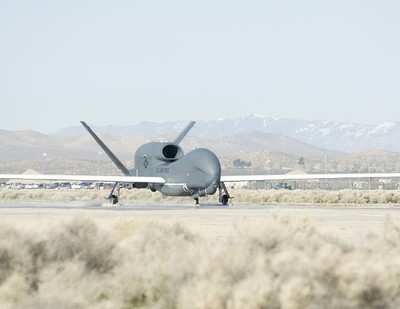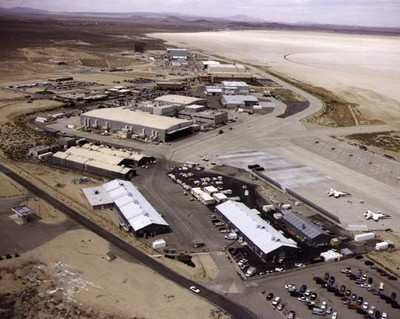"The Choreography Is Phenomenal" Flight Manager Says
Wet runway testing for the RQ-4 Global Hawk has been conducted
by the 453nd Flight Test Squadron at Edwards Air Force Base in CA
through the month of March. The wet runway test required the Global
Hawk to demonstrate taxiing and stopping from 6, 12, 30, 50 and 70
knots.

The Block 20 Global Hawk recently taxied down the 8,000-foot
runway at 70 knots, coming smartly to a stop and thus completing
the final speed requirement in the testing phase. "This testing is
for specification compliance, whether we can meet our targeted
landing and distance goal on a wet runway," said Dave Tangren, the
452nd FLTS lead engineer for flight systems. "Because our plane has
a completely new landing gear and brake system, we're looking
closely at anti-skid and stopping performance."
The Block 20 Global Hawk has a new electrical braking system
with a differential brake capability and anti-skid functions,
making it the only remotely piloted aircraft with this brake
design. Its predecessor, the Block 10 Global Hawk, uses a hydraulic
brake system. The different braking system on this significantly
larger Global Hawk version makes these tests crucial.
So how, exactly, are wet runway tests conducted in the desert?
To facilitate the tests, civil engineers sweep the runway for
foreign object debris in the pre-dawn darkness before the tests
begin. The runway is then watered down by contractors, and then
firefighters spray a diluted protein foam solution, which slows the
water run-off and helps keep the runway slippery. After the runway
is wet down, a truck equipped with a
runway-friction-measuring-system drives through the water to
measure the runway condition reading. The RCR needs to be between
13 and 17 indicating that the runway is indeed wet and provides
enough friction. "Basically a 21 or above is dry, a 13 to 17 is
wet, and 12 and below is icy," said Jan Rehacek, 452 FLTS
subsystems engineer. "This method quantifies how slippery the
runway is."
Once it is determined the runway is ready and personnel are
clear, the "go" command is sent and the Global Hawk begins its taxi
down the runway. The aircraft is followed by base officials in a
truck who serve as the eyes and ears of the test. The Global Hawk
must begin its taxi and acceleration within approximately 30
seconds after getting the green light. "If the time delay is too
great then the RCR will go up, and water will diminish across the
runway, so timing is critical," said Thomas Stiles, the 452nd FLTS
project manager.

Edwards Air Force Base
The wet runway test takes an enormous amount of coordination and
setup. Along with CE and firefighters, there are engineers,
controllers from Ridley Mission Control Center, contractors and
Airmen. "The choreography is phenomenal," said Stiles. "It's not
like an airplane taking off on a mission because there is so much
more ground activity involved and the choreography is critical.
Everybody is an intricate part of the testing, a total team
effort."
The 452nd FLTS staff is scheduled to wrap up the wet runway
testing in April. The successful completion of wet runway testing
marks some of the final testing requirements in the overall Block
20 Global Hawk testing prior to the initial operational test and
evaluation.
 Airborne-Flight Training 05.09.24: ERAU at AIAA, LIFT Diamond Buy, Epic A&P
Airborne-Flight Training 05.09.24: ERAU at AIAA, LIFT Diamond Buy, Epic A&P ANN's Daily Aero-Term (05.07.24): Hazardous Weather Information
ANN's Daily Aero-Term (05.07.24): Hazardous Weather Information Aero-News: Quote of the Day (05.07.24)
Aero-News: Quote of the Day (05.07.24) NTSB Final Report: Cessna 150
NTSB Final Report: Cessna 150 Aero-News: Quote of the Day (05.08.24)
Aero-News: Quote of the Day (05.08.24)




